Tourism in Libya
Tourism in Libya is an industry heavily hit by the Libyan Civil War. Before the war tourism was developing, with 149,000 tourists visiting Libya in 2004, rising to 180,000 in 2007, although this still only contributed less than 1% of the country's GDP. There were 1,000,000 day visitors in the same year.[1][2] The country is best known for its ancient Greek and Roman ruins and Sahara desert landscapes.
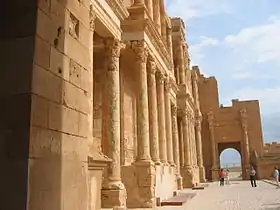
Libya is not issuing tourist visas now.[3] Libyan borders with Chad, Niger, Sudan and Algeria are closed.[4] In reality these borders are not controlled by the Government but by Tuareg people and Toubou people.[5]
As of 2017, governments of the United States,[6] New Zealand,[7] Australia,[8] Canada,[9] Republic of Ireland,[10] the United Kingdom,[11] Spain,[12] France,[13] Hungary,[14] Latvia,[15] Germany,[16] Austria,[17] Bulgaria,[18] Norway,[19] Croatia,[20] Romania,[21] Slovenia,[22] Czech Republic,[23] Russia,[24] Denmark,[25] Slovakia,[26] Estonia,[27] Italy,[28] Poland,[29] South Korea,[30] the Republic of China[31] Japan[32] and India advise their citizens against all (or in some cases all but essential) travel to Libya.
Main sites
Archeological sites
Cultural tourism is Libya's biggest draw as a tourism destination. There are five UNESCO World Heritage Sites in the country, three of which are classical ruins. The Roman cities of Sabratha and Leptis Magna in Western Libya and the Greek ruins of Cyrene in the East are big tourist attractions. One of the attractions of Libya's archeological sites, is that one located in the west south side of the country which called and known by The Jowely of the desert *The Old City of ghadames* they are not as heavily populated by tourists as are other ancient sites in North Africa and southern Europe.
Roman sites
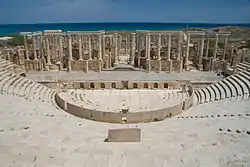
The Roman city of Sabratha lies 80 km (50 mi) west of the capital Tripoli. The port was established as a Phoenician trading-post around 500 BC. It later became part of the short-lived Numidian Kingdom of Massinissa before being Romanised and rebuilt in the 2nd and 3rd centuries AD. The city was badly damaged by earthquakes during the 4th century, and was rebuilt on a more modest scale by Byzantine governors. Besides the well preserved late 3rd century theatre, that retains its three-storey architectural backdrop, Sabratha has temples dedicated to Liber Pater, Serapis and Isis. There is a Christian basilica of the time of Justinian and remnants of some of the mosaic floors that enriched elite dwellings of Roman North Africa; the Villa Sileen near Al-Khoms is a good example. The mosaics are most clearly preserved in the coloured patterns of the seaward (or Forum) baths, directly overlooking the shore, and in the black and white floors of the theatre baths. There is a museum adjacent to the site which contains some excavated artifacts, whilst others are displayed at the National Museum in Tripoli.
Leptis Magna is the largest Roman city in Libya, and its ruins are some of the most complete and best preserved in the Mediterranean, providing Libya's biggest tourist attraction. Leptis Magna was founded by the Phoenicians in the 10th century BC. It survived the attention of Spartan colonists, and became a Punic city and eventually part of the new Roman province of Africa around 23 BC. As a Roman city it prospered, with figures like Emperor Septimius Severus as one of its emperors. The city was sacked by a Berber tribe in 523 AD, and later abandoned and reclaimed by the desert. Although it provided a source of building materials to various looters throughout history, it was not excavated until the 1920s. Today the site has many monuments still intact. The theatre is the most obvious, and has good panoramic views of the city from its upper tiers. The Hadrianic Baths are another attraction, and one of the pools, measuring 28 times 15 metre, remains intact. This bath house was one of the largest that was ever built outside Rome. The circus, nearly a kilometre away from the main site, remains still only partly excavated. At 450 by 100 metres, it was one of the largest in the entire Roman world. It is also the only one of its kind in Libya today. The Leptis Magna Museum of Leptis Magna contains many excavated artifacts, as well as recent discoveries such as five colorful mosaics created during the 1st or 2nd century AD.
Greek sites
Although Cyrene was later incorporated into the Roman Empire, it was founded in 630 BC as a colony of the Greeks from the Greek island of Thera. 16 kilometers from Cyrene is the port of Apollonia (Marsa Sousa). The city promptly became the chief town of ancient Libya and established commercial relations with all the Greek cities, reaching the height of its prosperity under its own kings in the 5th century BC. Soon after 460 BC, it became a republic, and after the death of Alexander III of Macedon (323 BC) it was passed to the Ptolemaic dynasty.
Ophelas, the general who occupied the city in Ptolemy I's name, ruled the city almost independently until his death, when Ptolemy's son-in-law Magas received governorship of the territory. In 276 BC Magas crowned himself king and declared de facto independence, marrying the daughter of the Seleucid king and forming with him an alliance in order to invade Egypt. The invasion was unsuccessful and in 250 BC, after Magas' death, the city was reabsorbed into Ptolemaic Egypt. Cyrenaica became part of the Ptolemaic empire controlled from Alexandria, and became Roman territory in 96 BC when Ptolemy Apion bequeathed Cirenaica to Rome. In 74 BC the territory was formally transformed into a Roman province.
The archeological site lies near the village of Shahhat. One of its more significant features is the temple of Apollo which was originally constructed as early as the 7th century BC. Other ancient structures include a temple to Demeter and a partially unexcavated temple to Zeus. There is a large necropolis approximately 16 km between Cyrene and its ancient port Apollonia. The Cyrene Museum also lies on the site.
Other Interesting Sites
Tripoli
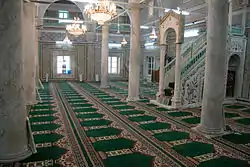
Tripoli is the de facto capital of Libya and was once known as the "White Bride of the Mediterranean". Throughout history, the city exchanged hands many times, and several historic mosques and other sites in the medina attest to this. The Turkish and Italian colonial periods left a distinctive mark on the city's architecture.
Easily the most dominant feature of Tripoli is the Red Castle, Assaraya al-Hamra, which sits on the northern promontory overlooking what used to be the sea - a motorway and 500 m (1640 ft) of reclaimed land now separate the two. The large structure comprises a labyrinth of courtyards, alleyways and houses built up over the centuries with a total area of around 13,000 square metres (140,000 sq ft). Inside, there is evidence of all the city's (and thus the citadel's) ruling parties: the Turks, Karamanlis, Spaniards, Knights of Malta, Italians and several others who all left their presence in its arts and architecture.
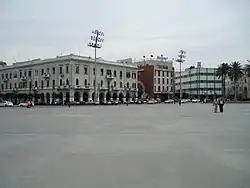
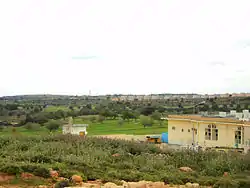
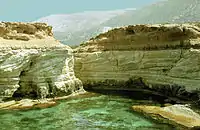

The entrance to the Jamahiriya Museum is on Martyr's Square, next to the castle. These facilities were built in consultation with UNESCO at enormous cost, and the exhibits within are laid out chronologically, starting with prehistory and ending up with the revolution. The most impressive parts are the mosaics, statues and artifacts from classical antiquity, which make up one of the best preserved collections in the Mediterranean.
The medina is the heart of Tripoli and provides the best sightseeing and shopping opportunities in the city for tourists. The basic street plan of the medina was laid down in the Roman period when the walls were constructed as protection against attacks from the interior of Tripolitania, and are considered well planned, possibly better than modern street plans. In the 8th century a wall on the sea-facing side of the city was added.
Three gates provided access to the old town: Bab Zanata in the west, Bab Hawara in the southeast and Bab Al-Bahr in the north wall; the city walls are still standing today. The bazaar is also known for its traditional ware; jewellery and clothes can be found in the local markets. Unlike neighbouring countries, Libya is known for its lack of hassle in the souqs. The old walled city also contains virtually all of Tripoli's historic mosques, khans (inns), hammams and houses. Other nearby attractions include the city's zoo and many of the nearby beaches.
Since the rise in tourism and influx of foreign businesspeople, there has been an increased demand for hotels in the city. To cater for these increased demands, the Corinthia Bab Africa hotel located in the central business district was constructed in 2003 and is the largest hotel in Libya. Other large hotels include the Bab El Bahr hotel and the Kabir Hotel as well as others.
Sahara desert

The Sahara desert represents more than 92% of the Libyan territories and is an important Libyan resource with many tourist attraction landmarks. This includes historic arts, agricultural, urban constructions and habitations in oases and desert lakes. Such a diversity in desert tourist phenomena in Libya gives several opportunities to perform entertainment, cultural and scientific activities to satisfy the desire of the adventurer tourist and the amateur sportsman tourist through the desert paths. Moreover, the natural beauty distinguishing the Libyan desert and its calm, isolation and simplicity of life present unlimited photographic opportunities.
The oases are considered in general among the most important desert tourist landmarks distinguished by their natural beauty. The oases are surrounded with sand dunes, and sometimes with lakes, which make all thereof distinct tourist attractive landscapes. This is in addition to the richness of such oases of their cultural heritage and old cities having distinct style, as the oases are the permanent green areas in the desert. The most important oases in the area are Ghadames oasis, Ghat oasis, Wadi Elhayat oases, Wadi Eshati oases, Jufra oases and Kufra oasis.
The desert mountains and hills in south Libya add other aesthetic aspects to the desert beauty.
Contemporary travel
The most common form of public transport between cities is the bus, but many people travel by automobile.
Libyan cuisine
Libyan cuisine is generally simple, and is very similar to Sahara cuisine with several Ottoman/Turkish and Italian influences. In many undeveloped areas and small towns, restaurants may be nonexistent, and food stores may be the only source to obtain food products. Some common Libyan foods include couscous, bazeen, which is a type of unsweetened cake, and shurba, which is soup. Libyan restaurants may serve international cuisine, or may serve simpler fare such as lamb, chicken, vegetable stew, potatoes and macaroni. Alcohol consumption is illegal in the entire country.
There are four main ingredients of traditional Libyan food: olives (and olive oil), palm dates, grains and milk.[33] Grains are roasted, ground, sieved and used for making bread, cakes, soups and bazeen. Dates are harvested, dried and can be eaten as they are, made into syrup or slightly fried and eaten with bsisa and milk. After eating, Libyans often drink mainly green and sometimes black tea. This is normally done in 3 rounds: 1st round without sugar or mint, 2nd round with sugar and mint (or sage), and 3rd round with the tea is served with roasted peanuts or roasted almonds (mixed with the tea in the same glass).[33]
References
| Wikimedia Commons has media related to Tourism in Libya. |
| Wikivoyage has a travel guide for Libya. |
- Annual Review of Developments in Globalization and Regional Integration in the Arab Countries, 2007. UN. p. 21. doi:10.18356/b9466ffc-en. ISBN 9789210557740. Retrieved 11 March 2018.
- "Tripoli, Libya – A Prosperous Prospect. - Tuesday, 23rd September 2008 at 4Hoteliers". 4hoteliers.com. Retrieved 11 March 2012.
- "Libyan Visa Centre". Retrieved 9 June 2015.
- "Libya seals its southern border". Retrieved 9 June 2015.
- Southern borders wide open
- "Alerts and Warnings". Retrieved 9 June 2015.
- "Libya". Retrieved 9 June 2015.
- "Libya". Archived from the original on 22 June 2013. Retrieved 9 June 2015.
- "Travel advice and advisories for Libya". Travel.gc.ca. Retrieved 9 June 2015.
- Department of Foreign Affairs. "Libya". Retrieved 9 June 2015.
- "Libya travel advice - GOV.UK". Retrieved 9 June 2015.
- "Pages - Recomendaciones de viaje". Retrieved 9 June 2015.
- Ministère des Affaires étrangères et du Développement international. "Libye". France Diplomatie :: Ministère des Affaires étrangères et du Développement international. Retrieved 9 June 2015.
- "Konzuli Szolgálat". Retrieved 9 June 2015.
- "mfa.gov.lv". Retrieved 9 June 2015.
- "Auswärtiges Amt - Reise- und Sicherheitshinweise". Auswärtiges Amt. Retrieved 9 June 2015.
- Außenministerium der Republik Österreich. "Land – BMEIA, Außenministerium Österreich – BMEIA, Außenministerium Österreich". Retrieved 9 June 2015.
- СТЕПЕНИ НА СИГУРНОСТ ПРЕПОРЪКИ И ПРЕДУПРЕЖДЕНИЯ ЗА ПЪТУВАНЕ
- "landsider.no : : Libya". Retrieved 9 June 2015.
- "MVEP • Opće informacije". Retrieved 9 June 2015.
- "Alerte de călătorie - Ministry of Foreign Affairs". Retrieved 9 June 2015.
- "Libija - Ministrstvo za zunanje zadeve". Retrieved 9 June 2015.
- "Libye: Varovní pro cesty". Retrieved 9 June 2015.
- "МИД рекомендовал россиянам отказаться от путешествия в Ливию". Retrieved 9 June 2015.
- "Libyen". Retrieved 9 June 2015.
- "Odporúčania pre slovenských občanov cestujúcich do Líbye - Aktuality - Aktuálne - Ministerstvo zahraničných vecí a európskych záležitostí Slovenskej republiky". Retrieved 9 June 2015.
- Liibüa reisiinfo
- "Viaggiare Sicuri - Libia". Retrieved 9 June 2015.
- "Libia – ostrzeżenie dla podróżujących". Retrieved 9 June 2015.
- S. Korea imposes travel ban on violence-ravaged Libya, Yonhap News, 30 July 2014
- http://focustaiwan.tw/news/aipl/201102210017.aspx
- http://www.ly.emb-japan.go.jp/consular_en.html
- Temehu.com. "Libyan Food"

